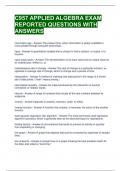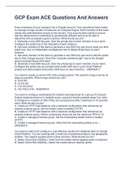Exam (elaborations)
C957 APPLIED ALGEBRA EXAM REPORTED QUESTIONS WITH ANSWERS
- Course
- Institution
C957 APPLIED ALGEBRA EXAM REPORTED QUESTIONS WITH ANSWERS information age - Answer-The present time, when information is widely available to many people through computer technology. input - Answer-A quantitative variable that is chosen to find a solution, or output, of a function. input-out...
[Show more]




